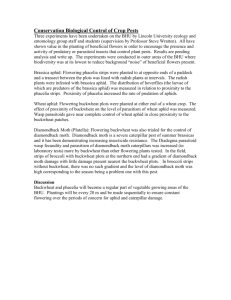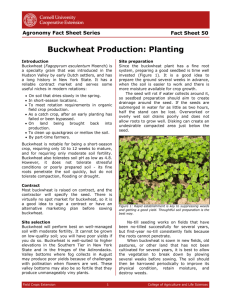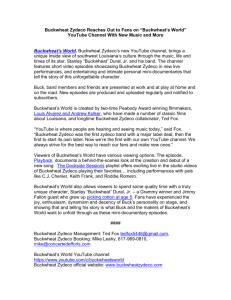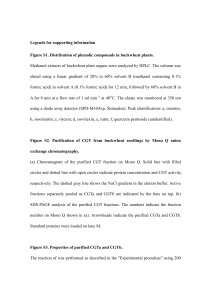A-687 Buckwheat Production - NDSU Agriculture
advertisement
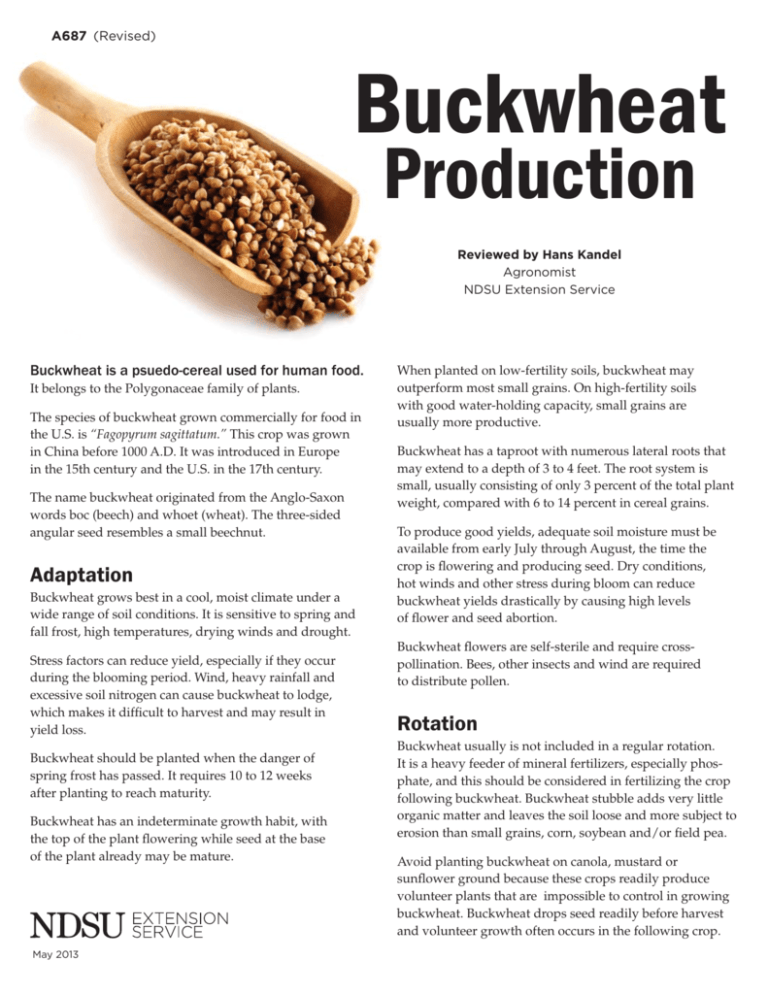
A687 (Revised) Buckwheat Production Reviewed by Hans Kandel Agronomist NDSU Extension Service Buckwheat is a psuedo-cereal used for human food. It belongs to the Polygonaceae family of plants. The species of buckwheat grown commercially for food in the U.S. is “Fagopyrum sagittatum.” This crop was grown in China before 1000 A.D. It was introduced in Europe in the 15th century and the U.S. in the 17th century. The name buckwheat originated from the Anglo-Saxon words boc (beech) and whoet (wheat). The three-sided angular seed resembles a small beechnut. Adaptation Buckwheat grows best in a cool, moist climate under a wide range of soil conditions. It is sensitive to spring and fall frost, high temperatures, drying winds and drought. Stress factors can reduce yield, especially if they occur during the blooming period. Wind, heavy rainfall and excessive soil nitrogen can cause buckwheat to lodge, which makes it difficult to harvest and may result in yield loss. Buckwheat should be planted when the danger of spring frost has passed. It requires 10 to 12 weeks after planting to reach maturity. Buckwheat has an indeterminate growth habit, with the top of the plant flowering while seed at the base of the plant already may be mature. May 2013 When planted on low-fertility soils, buckwheat may outperform most small grains. On high-fertility soils with good water-holding capacity, small grains are usually more productive. Buckwheat has a taproot with numerous lateral roots that may extend to a depth of 3 to 4 feet. The root system is small, usually consisting of only 3 percent of the total plant weight, compared with 6 to 14 percent in cereal grains. To produce good yields, adequate soil moisture must be available from early July through August, the time the crop is flowering and producing seed. Dry conditions, hot winds and other stress during bloom can reduce buckwheat yields drastically by causing high levels of flower and seed abortion. Buckwheat flowers are self-sterile and require crosspollination. Bees, other insects and wind are required to distribute pollen. Rotation Buckwheat usually is not included in a regular rotation. It is a heavy feeder of mineral fertilizers, especially phosphate, and this should be considered in fertilizing the crop following buckwheat. Buckwheat stubble adds very little organic matter and leaves the soil loose and more subject to erosion than small grains, corn, soybean and/or field pea. Avoid planting buckwheat on canola, mustard or sunflower ground because these crops readily produce volunteer plants that are impossible to control in growing buckwheat. Buckwheat drops seed readily before harvest and volunteer growth often occurs in the following crop. A grower should be careful to select a crop that has buckwheat-control options available. Bromoxynil, dicamba, Curtail M and Harmony Extra herbicides easily control volunteer buckwheat in small grain. Growers should select a crop following buckwheat for which these types of herbicides are labeled and can be used safely. temperature is about 80 F, but will germinate at any temperature between 45 F and 105 F. Seeding from May 25 to June 10 is suggested. Uniform stands sometimes are hard to obtain due to cool soil temperatures. Seeding after May 25 in North Dakota allows additional time for weed control tillage and for soil to warm. Buckwheat seeding should be timed to allow plant growth to take place in warm weather and seed to form in the cool weather of late summer. Disease problems rarely are encountered in buckwheat. As a precaution, however, a minimum of three years should be left between successive buckwheat crops in a rotation. Any type of stress, especially at flowering, can result in a poor seed set. Delayed seeding, however, does increase the risk of fall frost damage. When seeding is delayed beyond mid-June, severe yield reductions may occur (Figure 1). Later dates of planting result in a shorter growth period, shorter plants, slightly lighter seed, lower bushel weights and reduced seed yield. Variety Selection Producer selection of varieties often is controlled by the contracting company. These same companies also will supply the seed or a seed source for the purchase of high-quality seed. Because little breeding work or effort is being done on buckwheat, only a few varieties are available. Most of the buckwheat varieties are diploids. Because buckwheat is cross-pollinated, variety designations may not be valid except in certified seed lots. Varieties developed in Canada and Europe also could be considered. Seedbed Buckwheat is established most easily on a well-prepared, firm seedbed similar to that for flax or other small-seeded crops. Early to mid-June planting permits adequate control of several weed seedling flushes prior to seeding. Under good growing conditions, buckwheat will germinate and shade the ground quickly. Cultural control of weeds is important because few herbicides are labeled for weed control in buckwheat. Date of Seeding Young seedlings are very sensitive to frost, so seeding should be delayed until all danger of spring frost is past. Buckwheat seed germinates best when the soil Figure 1. Planting date effect on yield of Mancan buckwheat during three growing seasons at Langdon, N.D. Table 1. Buckwheat agronomic traits 2006-2010, averaged across locations.1 Variety Years Included Mancan Koma Manor Koto 2006-08 2006-10 2006-10 2006,9,10 1 2 Days to Plant First Flower Height Lodging Test 1,000 Kernel Weight Weight (days) (inches) (0-9) (lb/bu) (gram) 34 37 34 34 38 38 39 40 4.0 3.9 3.6 3.0 41.8 42.9 41.7 41.9 26.3 29.4 27.8 32.2 Locations include NDSU Research Center sites at Langdon, Carrington, Hettinger, Williston, Minot and Prosper, N.D. Lodging: 0 = all plants upright, 9 = plants flat on the ground. Source: NDSU Extension publication A1105 (2007-2011). Rate and Depth of Seeding If volunteer buckwheat could be harmful in the succeeding crop, then the green manure crop of buckwheat should be destroyed and tilled under before going to seed. Many organic growers use buckwheat as part of their rotation plan to build healthy soils. Buckwheat usually is sown with a grain drill or air seeder at the rate of 40 to 50 pounds of pure live seed per acre. Good stands help prevent lodging. Buckwheat does not tiller; each seed produces a single stem that branches toward the top as field space permits. The preferred seeding depth is 1 to 1.5 inches if the soil moisture for germination is adequate. Seeding deeper than 2 inches should be avoided. Harvesting The crop begins to flower four to five weeks after planting and continues to flower and produce seed until freeze-up. The crop should be swathed prior to a killing frost at a stage when the crop appears it will produce the largest seed yield. A killing frost on a standing crop results in considerable harvest difficulty plus yield loss due to shattering and lodging. Fertilizer Buckwheat’s response to phosphate fertilizer is similar to that of small grains. Nitrogen levels should remain relatively low because of the tendency of the crop to lodge. See Table 2 for soil nutrient needs of buckwheat based on yield goals. For details, see publication SF882 (2010). “North Dakota Fertilizer Recommendation Tables and Equations.” Swathing sometimes is made difficult by the succulent nature of the stems. Research conducted in Canada indicates the optimum time for swathing to obtain maximum yields is when flowering is near completion and about 25 percent of the seeds are still green. If shattering becomes severe, the crop should be swathed immediately. Green Manure Crop The crop should be swathed in the morning when it is wet with dew or in damp periods to avoid seed shattering. Because stems are succulent, they require considerable time to dry. A frost while the crop is in the swath speeds drying. Buckwheat can be used as a beneficial green manure crop because it can produce significant amounts of dry matter. Up to 3 tons of dry matter per acre have been obtained after seven to eight weeks of growth. When plowed or tilled under, the plant materials decay rapidly, making nitrogen and mineral constituents available for subsequent crops. The heavy, dense growth of buckwheat also tends to suppress weeds to some extent. Buckwheat is threshed with a combine set at a cylinder speed of 600 to 800 rpm. Producers should take care in threshing because seed cracking can result. If excessive cracking or hulling occurs, decreased cylinder speed or wider concave clearance may be necessary. When a second crop of green manure is desired, winter rye may be seeded into the worked-down buckwheat and plowed under the following spring for even better soil-building results. Buckwheat green manure also may fit into a fairly tight rotation following an early crop harvest (mid-July) where sufficient growth will occur before incorporation with fall tillage. Buckwheat can be stored safely at 13 percent moisture content for long-term storage. When shorter-term storage is needed and when environmental conditions are cool (under 50 F), buckwheat should be stored at 15 percent moisture or less. If the crop must be dried, the maximum drying temperature is 110 F. Table 2. Fertilizing buckwheat. Soil Test Phosphorus, ppm Yield potential Soil N plus fertilizer N required bu/a lb/a lb/acre-2’ 25 30 35 40 1,200 1,450 1,675 1,925 55 651 751 901 Bray-1 Olsen VL 0-5 0-3 L 6-10 4-7 M 11-15 8-11 H 16-20 12-15 ——————— lb P2O5/acre ——————— 30 36 42 48 22 26 30 35 13 16 19 21 5 6 7 8 N recommendation = 2.2 x yield potential in bu/acre – soil test N – previous crop credit. 1 N fertilzer rates greater than 50 lb/acre can cause lodging in wet years. Bray-1 P recommendation = (1.32 - [0.066 x soil test P]) x yield potential in bu/acre. Olson P recommendation = (1.32 - [0.083 soil test P]) x yield potential in bu/acre. K recommendation = (1.86 - [0.0116 x soil test K]) x yield potential in bu/acre. Source: NDSU Extension Publication SF882 (2010). Soil Test Potassium, ppm VH 21+ 16+ 0 0 0 0 VL 0-40 L M H VH 41-80 81-120 121-160 161+ ——————— lb K2O/acre ——————— 41 49 57 65 29 35 41 47 18 21 25 28 6 7 8 9 0 0 0 0 Never, under any circumstances, should producers mix old-crop and new-crop buckwheat because market grades differ and market discounts or loss of contract may occur. Table 3. Buckwheat yield 2006-2010, averaged across locations1. Variety 2006 Pests Mancan Koma Manor Koto 1,117 918 1,084 998 1,734 1,748 1,799 – 1,188 1,165 1,081 – – 1,950 1,916 2,096 – 1,701 1,794 1,616 Mean LSD 0.05 1,029 NS 1,760 NS 1,145 NS 1,987 130 1,704 NS 2007 2008 2009 2010 —————————— Yield (lb/acre) —————————— Buckwheat suffers relatively little damage from diseases or insects. The diseases most common are leaf spot and root rot. Wireworms and aphids occasionally attack buckwheat. Weed Control 1 Few herbicides are cleared for use on buckwheat in North Dakota. Because few herbicides are available, plant buckwheat on land that is relatively weed-free. However, under normal conditions, weed pressure usually is not great. When planted in warm soils with rapid emergence and growth, buckwheat is a strong competitor with most annual weeds. Avoid planting in fields with a history of perennial weed infestation and field history of crops that have high potential for volunteers, such as canola, mustard and sunflower. Yield Grain yields at various Research Extension Center locations in North Dakota have varied significantly, depending on the growing season (Table 3). Because buckwheat is so sensitive to many stress factors, predicting yield is hard. Weather is the most limiting yield factor. Locations include NDSU Research Extension Center sites at Langdon, Carrington, Hettinger, Williston, Minot and Prosper, N.D. Source: NDSU Extension publication A1105 (2007-2011). Marketing Buckwheat almost always is grown under contract, with seed of the preferred variety furnished by the contracting company. Buckwheat must be marketed the year it is produced, so most buckwheat is sold under contract. Not all local grain elevators handle buckwheat. Producers should inquire about possible contracts and market outlets before beginning a production program. Buckwheat is sold by the hundredweight. The North Dakota State Seed Department has established marketgrading factors for buckwheat. Contact that office for grading standards information. ▼▲▼ This publication was authored by Duane R. Berglund, professor emeritus and former Extension agronomist, NDSU, 2003 For more information on this and other topics, see www.ag.ndsu.edu NDSU encourages you to use and share this content, but please do so under the conditions of our Creative Commons license. You may copy, distribute, transmit and adapt this work as long as you give full attribution, don’t use the work for commercial purposes and share your resulting work similarly. For more information, visit www.ag.ndsu.edu/agcomm/creative-commons. North Dakota State University does not discriminate on the basis of age, color, disability, gender expression/identity, genetic information, marital status, national origin, public assistance status, sex, sexual orientation, status as a U.S. veteran, race or religion. Direct inquiries to the Vice President for Equity, Diversity and Global Outreach, 205 Old Main, (701) 231-7708. County Commissions, NDSU and U.S. Department of Agriculture Cooperating. This publication will be made available in alternative formats for people with disabilities upon request, (701) 231-7881. 300-5-13

